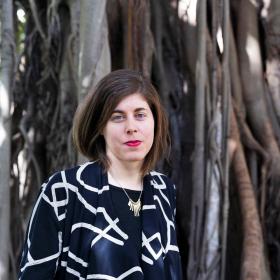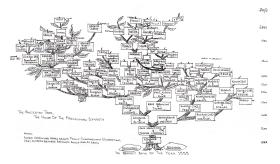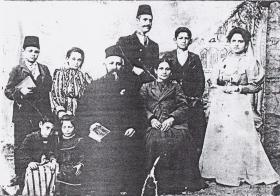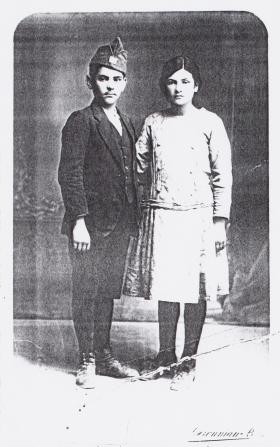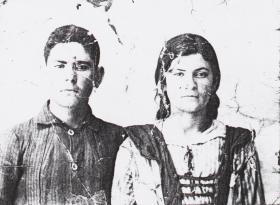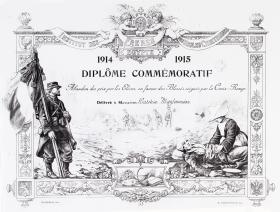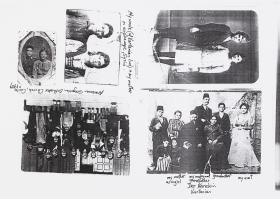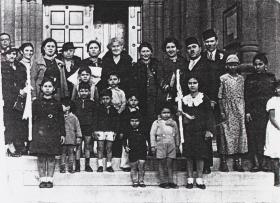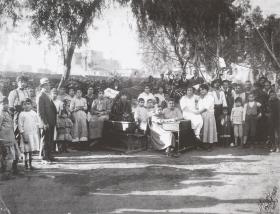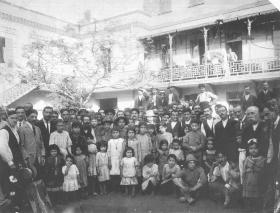It’s the last page, at the bottom of the sheaf of documents labelled ‘Mazloumian family papers, 1897–1939’, that makes my breath catch.
A hand-drawn family tree fills the A3 page. Both a lineage and a literal tree, it features a wide trunk with names marked on branches and leaves.
In ‘The Ancestry Tree: The House of the Mazloumian Dynasty’, the tree’s base marks the union of Massigiank and Bedeviank in ‘the perfect date of the year 1555’. Its branches spread across the page with the names of individuals and couples.
The family tree is patriarchal, tracing the surname and thus the Mazloumian men. The daughters of each generation appear on leaves, waiting to be plucked from their branches and married off into other families. A y-axis marks every half century, projecting forwards to 2050. Some names are followed by a number in parenthesis; a note explains that this is the age at death. The youngest, Bedros, is two. The oldest, Hratch, was 83.
Besides its earnest artistry, what strikes me about the family tree is the cities and countries that float above some names. First appearing in the late 1700s, they include Syria, Lebanon, Palestine, Egypt, England and Canada, as well as ‘Allepo’ and ‘Soudan’. Next to one couple, Hratch and Armenouhi, is a note: ‘Arrived Aust 1963’.
The tree is a history of the Mazloumian family, but in its scattering of the family across four continents, it also tells the greater Armenian story. The traditional Armenian homelands date back at least 3000 years. At its peak, the Armenian Empire stretched from the Black Sea to the Caspian and south to the Mediterranean, and was a rival to ancient Rome. In the perfect date of the year 1555, when Massigiank and Bedeviank married, much of the Armenian homelands were part of the expanding Ottoman Empire.
This family tree is remarkable because, for many Armenians, tracing their families back more than a few generations isn’t possible. During World War I, Armenian communities were the target of systematic destruction orchestrated by the Ottoman government. As many as 1.5 million people died, killed outright or marched across the desert toward Syria with only what they could carry. Some victims were transported by train. Some were pushed into caves, then asphyxiated by smoke. The violence prompted the creation of the term genocide, and laid the blueprints for the Holocaust.
My great grandparents Paravon and Mariam survived the genocide but lost nearly their entire families. Paravon had an uncle who’d travelled to Canada to find work before the war. In 1920, still living near Niagara Falls, Ontario, he brought Paravon and Mariam over, likely on a family visa. At that time, Canada wasn’t accepting ‘Asiatic’ refugees.
Across the United States, Europe, the Middle East and the Soviet Union, diasporan Armenian communities grew or formed in the years following the genocide. But Australia was not accepting Armenians, as refugees or otherwise. In 1950, there were only 500 Armenian Australians, according to sociologist James Kirkland, some of whom had arrived in the 1800s.
After the White Australia policy was abandoned, the population grew to 10,000 by 1976, and today it is approximately 50,000.
When Hratch and Armenouhi Mazloumian migrated to Australia, they became part of a community that is, for the most part, twice displaced. Many Armenians came to Australia from across the Middle East, where their parents or grandparents had settled after the genocide. Some came from Armenian communities in Iran that date back to the sixteenth century. Others came from families that have lived within the borders of present-day Armenia for generations, territory annexed first by the Russian Empire and then by the Soviets.
According to the Library’s catalogue record, the Mazloumian family emigrated to Australia from Egypt and one of its members was a ‘chemist-inventor of eyedrops and cream in Egypt’. This was Hovanes, according to the family tree, who was born in 1872 and died in 1943. Hovanes received his ‘Diplome de Maitre en Pharmacie’ — dated ‘26 octobre 1313/1897’, according to the Muslim and Christian calendars — from the Faculty of Medicine in Constantinople, the Ottoman capital. The diploma was issued in both French, an unofficial second language, and what must be Turkish, which at that time was written using the Arabic alphabet.
The pharmacy diploma was awarded in the name of ‘Le Sultan Abdul Hamid II’. Seeing his name startled me. Known as the Red Sultan, Abdul Hamid II was responsible for the massacres of tens of thousands of Ottoman Armenians. The violence, lasting from 1894 to 1896, was a precursor to the genocide. But Constantinople, a city full of foreign diplomats, was generally safer, both in the 1800s and during the genocide. Hovanes went on to achieve a master’s degree in medicine ‘of the highest marks and calibre’, a notation on the parchment copy reads.
The Mazloumian family papers tell an incomplete story. One document says that Hovanes was born in Aleppo, but another states that his family was from Yerevan. Regardless, at some point after completing his education, he established his business in Cairo. It’s unclear if this was an intentional escape from the nationalism fomenting across the decaying Ottoman Empire, or if Hovanes had other reasons for choosing Egypt.
Of Hovanes’s three sons, it was Hratch – he who lived to the age of 83 – who brought the Mazloumian lineage, along with his father’s papers, to Australia. A number of the papers give clues about his life. From about age 16 to 17, he studied at a Christian school in Egypt. In 1917, during World War I, he was in Paris studying at the Academie Stenographique, where he earned a Diplôme Supérieur.
Returning to Egypt, Hratch worked as a typist for the military. Hratchia (his first name appears across his documents with a variety of spellings) was 21 in August 1919, the year his military ID card was issued. On the archived copy of the card, his residence is listed as ‘Pharmacie Mazloumian’. Another ID card grants Hratghia Mazloumian, an ‘Arminian’, permission to enter the Port of Suez. The accompanying photo shows a serious young man, thick eyebrows dominating his thin face. He sports a white collared shirt paired with a dark tie and a wispy moustache.
His name is spelled differently yet again in the Commonwealth of Australia Gazette, which records Hartachia Mazloumian receiving Australian citizenship on 8 December 1969.
While one of Hovanes’s sons was emigrating from Egypt to the Antipodes, another was in Syria, according to the single newspaper clipping, ‘Where trail-blazers and spies stopped the night’, among the family papers. There’s no indication of where the article appeared, though an offhand mention of aviator Charles Kingsford Smith suggests it’s Australian. It traces the history of the landmark Hotel Baron in Aleppo, built in 1909 and frequented by the likes of Agatha Christie and Lawrence of Arabia. Since the early 1930s, the hotel had ‘been under the direction of Koko Mazloumian’.
In 1991, a decade after his uncle Hratch had passed away in Sydney, Koko was still sipping Armenian brandy at the Hotel Baron, according to an article in the Canberra Times. The war in Syria forced the hotel to close in 2012.
Living outside the traditional Armenian homelands targeted by the Ottoman government, Hovanes and his sons remained safe throughout the genocide. The woman who would be Hratch’s wife, Armenouhi, wasn’t so lucky. The family papers include her photograph, taken at an orphanage in Syria in 1920. She was likely one of the hundreds of thousands of survivors displaced from Ottoman Armenia. There’s no indication of how she and Hratch met.
I like to imagine Hratch making the trip from Cairo to visit his family in Aleppo. This is likely the city where Armenouhi found herself, among the many Armenian refugees who ended up there. Perhaps she was even working as a maid at the Hotel Baron when Hratch arrived from Cairo.
‘The Ancestry Tree: The House of the Mazloumian Dynasty’ represents a tiny slice of Armenia’s international diaspora, as well as the multicultural mosaic of New South Wales residents. The copy archived with the Library is not the original, and I hope whoever has the handwritten version continues to add to it. The page offers space for the next generation, the one that will carry the descendants of Massigiank and Bedeviank into the year 2050, and beyond.
